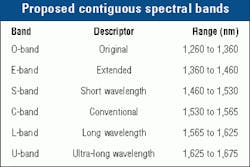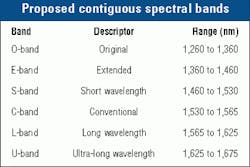ITU proposes spectral bands
BY WILLIAM B. GARDNER
The need for a common terminology when referring to the various spectral bands in use was reported in this column a year ago (see Lightwave, January 2000, p. 32). This issue was dealt with at last September's meeting of the International Telecommunication Union (ITU) Question 16/15 in Viareggio, Italy, chaired by John Eaves (TyCom Ltd., USA). ITU Study Group 15 in its February 2001 meeting will consider whether to incorporate the proposal from the Viareggio meeting into a new ITU Recommendation. This Recommendation, "Optical system design and engineering considerations," referred to for the present as G.dsn, is being edited by Felix Kapron (Corning, USA).
Using input from fiber, component, and systems experts, the delegates in Viareggio proposed six contiguous spectral bands, which cover the entire spectrum of 1,260 to 1,675 nm (see Table). Associated with this set of definitions are two notes:
- The definition of spectral bands is for classification purposes only and not for specification.
- The classification for multimode fibers is left for further study. The region 770 to 910 nm has been proposed.
Recent advances in fiber water-peak reduction (see Lightwave, September 1999, p. 24) and in the control of long-wavelength attenuation (see Lightwave, September 1998, p. 20) have made the transmission of client signals in the E- and L-bands feasible. Possibilities for the U-band are more limited, since fibers are not characterized in this band. The delegates in Viareggio are communicating with ITU Study Group 6 (Outside Plant) on the appropriate use of the U-band. Study Group 6's Recommendation L.41 assigns wavelengths for fiber identification, fault location, and maintenance monitoring in the L- and U-bands.
If approved by ITU Study Group 15 next month, this proposal will provide a common nomenclature that should reduce the chances of misunderstanding when spectral bands are discussed.William B. Gardner represents Lucent Technologies (Norcross, GA) on several fiber standards committees. He can be contacted at tel: (770) 798-2674; fax: (770) 798-4654; e-mail: [email protected].

